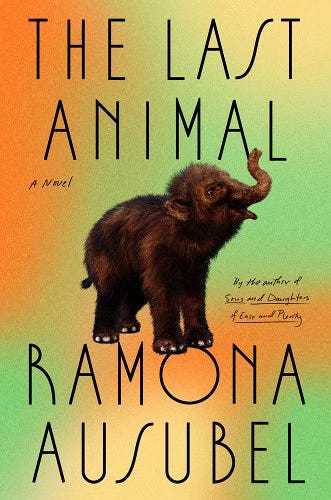You and me, baby, ain't nothin' but mammals
The Last Animal, New Animal, and the animal in all of us

Something I completely failed to consider, even though I knew I was moving east, was that the sun sets a little earlier here, about half an hour earlier than it does back in Waterloo. Today it is projected to set at 4:28pm, and it’s mid-November.
I know most people are able to just get on with it, and live their lives according to what the clock says, as opposed to what the sun is doing. But I’m just not one of them.
The amount and quality of daylight directly impacts my mood, which in turn impacts my productivity. At this time of year, I often find myself struggling to do the kinds of complex tasks that distinguish humans, as a species, from other animals. Things like, say, writing this newsletter. On the coldest, bleakest days, all I want to do is sleep, eat, and then sleep some more. When the sun is out, I can’t stay still indoors. I make up reasons to go out, preferably on foot, and as I walk, I try not to feel bad about everything I’m leaving behind me, undone.
Something about my full-body response to this time of year, my almost panicky impulse to maximize my exposure to the dwindling warmth and daylight, always reminds me that humans are animals, first and foremost, even if we are increasingly encouraged to think of ourselves as machines.
Consequently (or maybe just coincidentally) I picked up two books with the word ‘animal’ in the title in the last month or so. I read The Last Animal and New Animal back to back, and I highly recommend this experience.

The Last Animal cleverly blends climate science with a tender family/coming-of-age story—perhaps the ideal fiction pick for anyone who read and loved Lab Girl as much I did. This novel tells the story of Jane, a struggling grad student and single mother of two teen daughters, and their wild, super-secret quest to reintroduce the woolly mammoth as way of combating climate change. By doing this, the women are continuing the research started by their late husband/father, Sal, a charismatic professor who died in a car accident a few years ago.
The perspective is third person, though most closely aligned with Vera’s point of view. The youngest of Jane’s daughters, Vera is just twelve when the story begins, and is particularly hopeful that returning to the last place her father was alive will help her to reconnect with him. And it does, though not in the calming, consistent way she expects:
Sometimes he slammed forth, universe-sized, absolutely everywhere, but Vera did not get to choose when this happened. She had to take him how he came, whisper or bang, and she had to learn to love his absence, too, because the empty space was also her dad.1
Shortly after this passage, Vera takes a stone from the cliff where her father’s car crashed, and puts it in her pocket because it feels “like something she’d always need.”
The loss of a parent, and the evolution of that parent-child relationship after the loss, is a theme in New Animal as well—and this story is also told from the perspective of a bereaved daughter. Amelia Aurelia, a cosmetic mortician working for her family’s funeral home, is in her mid-twenties when her mother meets with a tragic accident. Finding herself completely unable to face the funeral, Amelia leaves town the day before the service and runs to Tasmania, to be with the birth father her mother divorced, years ago.
Like Vera, Amelia is desperate to connect with her deceased parent, and also attempts to do it through physical objects, cliffside. She puts her mother’s favourite pair of earrings, beaded chandeliers, under the band of her bra, craving the “physical dent of them”; she wants to feel the impression of her mother’s things on her body “like pressed tin.” Later, when she finds the earrings are not helping her to feel any better or closer to her mother, she hurls them over the edge of a cliff, and feels “comforted by something of hers being on the mountain, along with everything else that is good.”

These scenes stayed with me, long after I finished both books—I couldn’t stop thinking about how one grieving daughter chose a talisman to keep, while the other threw hers away, and the outcome was essentially the same. Both felt a tiny a bit better, for reasons they probably couldn’t fully explain to anyone else, because grief is as idiosyncratic as it is universal. There’s no right or wrong way to go through it.
Some coping strategies, however, are more fraught with peril than others, both for the grieving person and anyone else they might involve, which brings me to one more theme these books have in common: sex2. It drives the plot of both books, and almost none of it is the romantic variety. Without spoiling too much, I can tell you that The Last Animal revolves around not one but two instances of ethically ambiguous artificial insemination, and the animal in the title of New Animal is Shakespeare’s ‘beast with two backs.’ Casual sex has been a big part of Amelia’s life for years, and the pain of her mother’s death inspires her to take it a whole new level.
I’m not a particularly prudish reader, but I do feel the need to warn readers that Amelia experiments with BDSM as a way to avoid her emotional pain and it gets….messy. (If you need or want to know a little more before giving this book a go, I highly recommend this review from
. )I wish I could come up with an elegant way to close this post but the fact of the matter is, the sun is out, and I’m antsy as hell. I’m going to walk to the grocery store and bring home an impractically small amount of food, so that I will have to go out and do it again tomorrow.
I’m not crying. You’re crying.
This shared theme was on my mind when I chose the title of this post, and I apologize if you’re now humming this very NSFW song.




Thanks for the shoutout! When your newsletter hit my inbox I was like, wait, is that a line from that Discovery Channel song??? 😂